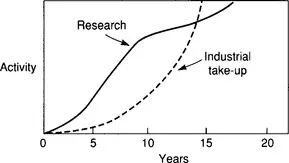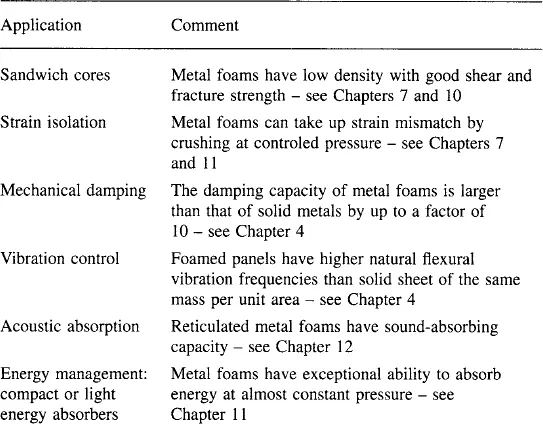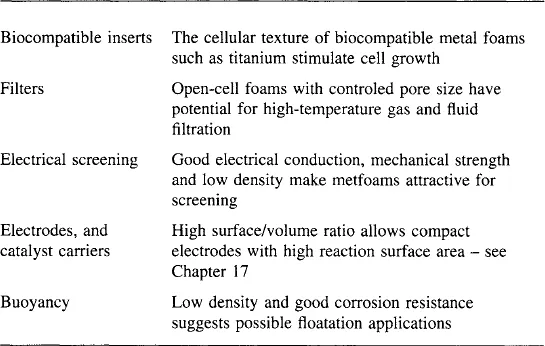
eBook - ePub
Metal Foams: A Design Guide
Michael F. Ashby, Tony Evans, NA Fleck, J.W. Hutchinson, H.N.G. Wadley, L. J. Gibson
This is a test
Partager le livre
- 251 pages
- English
- ePUB (adapté aux mobiles)
- Disponible sur iOS et Android
eBook - ePub
Metal Foams: A Design Guide
Michael F. Ashby, Tony Evans, NA Fleck, J.W. Hutchinson, H.N.G. Wadley, L. J. Gibson
Détails du livre
Aperçu du livre
Table des matières
Citations
À propos de ce livre
Metal foams are at the forefront of technological development for the automotive, aerospace, and other weight-dependent industries. They are formed by various methods, but the key facet of their manufacture is the inclusion of air or other gaseous pockets in the metal structure.
The fact that gas pockets are present in their structure provides an obvious weight advantage over traditionally cast or machined solid metal components. The unique structure of metal foams also opens up more opportunities to improve on more complex methods of producing parts with space inclusions such as sand-casting. This guide provides information on the advantages metal foams possess, and the applications for which they may prove suitable.
- Offers a concise description of metal foams, their manufacture, and their advantages in industry
- Provides engineers with answers to pertinent questions surrounding metal foams
- Satisfies a major need in the market for information on the properties, performance, and applications of these materials
Foire aux questions
Comment puis-je résilier mon abonnement ?
Il vous suffit de vous rendre dans la section compte dans paramètres et de cliquer sur « Résilier l’abonnement ». C’est aussi simple que cela ! Une fois que vous aurez résilié votre abonnement, il restera actif pour le reste de la période pour laquelle vous avez payé. Découvrez-en plus ici.
Puis-je / comment puis-je télécharger des livres ?
Pour le moment, tous nos livres en format ePub adaptés aux mobiles peuvent être téléchargés via l’application. La plupart de nos PDF sont également disponibles en téléchargement et les autres seront téléchargeables très prochainement. Découvrez-en plus ici.
Quelle est la différence entre les formules tarifaires ?
Les deux abonnements vous donnent un accès complet à la bibliothèque et à toutes les fonctionnalités de Perlego. Les seules différences sont les tarifs ainsi que la période d’abonnement : avec l’abonnement annuel, vous économiserez environ 30 % par rapport à 12 mois d’abonnement mensuel.
Qu’est-ce que Perlego ?
Nous sommes un service d’abonnement à des ouvrages universitaires en ligne, où vous pouvez accéder à toute une bibliothèque pour un prix inférieur à celui d’un seul livre par mois. Avec plus d’un million de livres sur plus de 1 000 sujets, nous avons ce qu’il vous faut ! Découvrez-en plus ici.
Prenez-vous en charge la synthèse vocale ?
Recherchez le symbole Écouter sur votre prochain livre pour voir si vous pouvez l’écouter. L’outil Écouter lit le texte à haute voix pour vous, en surlignant le passage qui est en cours de lecture. Vous pouvez le mettre sur pause, l’accélérer ou le ralentir. Découvrez-en plus ici.
Est-ce que Metal Foams: A Design Guide est un PDF/ePUB en ligne ?
Oui, vous pouvez accéder à Metal Foams: A Design Guide par Michael F. Ashby, Tony Evans, NA Fleck, J.W. Hutchinson, H.N.G. Wadley, L. J. Gibson en format PDF et/ou ePUB ainsi qu’à d’autres livres populaires dans Tecnología e ingeniería et Ingeniería minera. Nous disposons de plus d’un million d’ouvrages à découvrir dans notre catalogue.
Informations
Sous-sujet
Ingeniería mineraChapter 1
Introduction
Metal foams are a new, as yet imperfectly characterized, class of materials with low densities and novel physical, mechanical, thermal, electrical and acoustic properties. They offer potential for lightweight structures, for energy absorption, and for thermal management; and some of them, at least, are cheap. The current understanding of their production, properties and uses in assembled in this Design Guide. The presentation is deliberately kept as simple as possible. Section 1.1 expands on the philosophy behind the Guide. Section 1.2 lists potential applications for metal foams. Section 1.3 gives a short bibliography of general information sources; further relevant literature is given in the last section of each chapter.
At this point in time most commercially available metal foams are based on aluminum or nickel. Methods exist for foaming magnesium, lead, zinc, copper, bronze, titanium, steel and even gold, available on custom order. Given the intensity of research and process development, it is anticipated that the range of available foams will expand quickly over the next five years.
1.1 This Design Guide
Metallic foams (‘metfoams’) are a new class of material, unfamiliar to most engineers. They are made by a range of novel processing techniques, many still under development, which are documented in Chapter 2. At present metfoams are incompletely characterized, and the processes used to make them are imperfectly controled, resulting in some variability in properties. But even the present generation of metfoams have property profiles with alluring potential, and the control of processing is improving rapidly. Metfoams offer significant performance gains in light, stiff structures, for the efficient absorption of energy, for thermal management and perhaps for acoustic control and other, more specialized, applications (Section 1.2). They are recyclable and nontoxic. They hold particular promise for market penetration in applications in which several of these features are exploited simultaneously.
But promise, in today’s competitive environment, is not enough. A survey of the history of development of new material suggests a scenario like that sketched in Figure 1.1. Once conceived, research on the new material accelerates rapidly, driven by scientific curiosity and by the often over-optimistic predictions of its potential impact on engineering. The engineering take-up, however, is slow, held back by lack of adequate design data, experience and confidence; the disappointing take-up leads, after some 5 or 10 years, to disillusionment and a decline in research funding and activity. On a longer time-scale (15 years is often cited as the typical gestation period) the use of the new material – provided it has real potential – takes hold in one or more market sectors, and production and use expands, ultimately pulling research and development programmes with it.

Figure 1.1 A development history typical of many new materials. Research into the new material grows rapidly, and then slumps when little interest is shown by industry in using it. On a longer (15-year) time scale, applications slowly emerge
There are obvious reasons for seeking a better balance between research and engineering take-up. This Design Guide is one contribution to the effort to achieve faster take-up, to give development curves more like those of Figure 1.2. Its seeks to do this by

Figure 1.2 A more attractive development history than that of Figure 1.1. Early formulation of design rules, research targeted at characterizing the most useful properties, and demonstrator projects pull the ‘take-up’ curve closer to the ‘research’ curve
• Presenting the properties of metallic foams in a way which facilitates comparison with other materials and structures
• Summarizing guidelines for design with them
• Illustrating how they might be used in lightweight structures, energy-absorbing systems, thermal management and other application, using, where possible, case studies.
The Guide starts with a description of the ways in which metfoams are made (Chapter 2) and the methods and precautions that have evolved for testing and characterizing them (Chapter 3). It continues with a summary of material properties, contrasting those of metfoams with those of other structural materials (Chapter 4). Chapter 5 outlines design analysis for materials selection. This is followed in Chapter 6 by a summary of formulae for simple structural shapes and loadings; the ways in which the properties of metal foams influence the use of these formulae are emphasized.
Mechanical design with foams requires constitutive equations defining the shape of the yield surface, and describing response to cyclic loading and to loading at elevated temperatures. These are discussed in
Chapters 7, 8 and 9. One potential application for foams is that as the core for sandwich beams, panels and shells. Chapter 10 elaborates on this, illustrating how the stiffness and strength of weight-optimized sandwich structures compare with those of other types. Chapters 11, 12 and 13 outline the use of metal foams in energy, acoustic and thermal management. Chapter 14 describes how they can be cut, finished and joined. Chapter 15 discusses economic aspects of metal foams and the way economic and technical assessment are combined to establish viability. Chapter 16 reports case studies illustrating successful and potential applications of metal foams. Chapter 17 contains a list of the suppliers of metal foams, with contact information. Chapter 18 lists Web sites of relevant research groups and suppliers. The Guide ends with an Appendix in which material indices are catalogued.
1.2 Potential applications for metal foams



1.3 The literature on metal foams
The body of literature on metal foams is small, but growing quickly. The selection below gives sources that provide a general background. Specific references to more specialized papers and reports are given at the end of the chapter to which they are relevant.
Banhart J., ed. Metallschäume. Bremen: MIT Verlag, 1997.
Banhart J., Ashby M. F., Fleck N. A., eds. Metal Foams and Foam Metal Structures, Proc. Int. Conf. Metfoam’99. ...